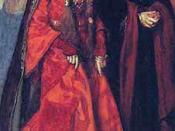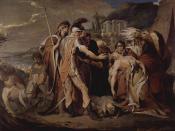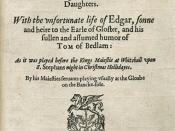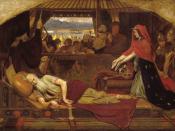KING LEAR CRITICAL STUDY "The Opening of any drama must mesmerise the audience"æ"àHow is this achieved in King Lear? In your answer you must refer to the core text Act I, Scene I.
King Lear mesmerises the audience in its opening scene through a clear establishment of the story and the characters and in doing so, instigates an audience response to the issues and characters that effectively keeps them interested in the play. Established in the opening scene are the characters and their relationship with one another; the parallels between the plot and sub-plot; and most importantly, the protagonist, Lear, and the consequences of her most unusual decision. Because the audience is given so much information straight away, the formation of issues in the play and evaluations of characters are made, thus interesting the audience immediately. To identify how the audience is mesmerised at the beginning of the play we must ask two questions: what does the opening scene establish?, and how is the audience response encouraged?.
Characters are established very early in Act I through the setting of the courtroom, a place where many people are involved. Lear's authoritative personality is shown through this setting, but also highlights his foolishness and pettiness. His decision "ÃÂTo shake all cares and businesses from our age; Conferring them on younger strengths while we; Unburdered crawl toward death' highlights not only his irresponsibility as King, but is also recognised as one of the key actions in the play that influences many others further on.
Through this decision, we see the gushing falseness of his daughters Gonerill and Regan (who at the end of Scene I) reveal their true colours as they discuss their plans to obliterate their newfound responsibility to look after him. Cordelia is also introduced in great detail, where we see her honesty (through her decision to not passionately proclaim her love to her father), strength (when she withstands the following onslaught from Lear) and pride (when she leaves, at the instigation of her newly intended husband King of France, proud of her decision and still offering her love to her sisters). Immediately our support goes out to Cordelia, when she is left without a dowry and put forward to her prospective husbands of France and Burgundy, and humiliated, and away from her sisters and Lear. Kent is another whose character is strongly defined, as we see his loyalty to Lear, and his commonsense and realistic attitude toward the situation "ÃÂ as he develops into Lear's "ÃÂconscience', our sympathy goes out to him also when he is banished. All of the main characters in the main plot are developed so that the viewer is interested in them, and makes their own evaluation of their character.
The relationship between Gonerill and Regan with their father is identified, when afterward, they recognise that "ÃÂHe always loved our sister most' and with that comment the audience recognises the possibility of tension through jealousy. We are shown that Lear does favour Cordelia most, promising her the greatest part of his land. Lear's relationship with Kent, as their personalities clash "ÃÂ Lear being spontaneous and unpredictable and Kent being practical and reasonable. We recognise Kent's loyalty to his king when he speaks out of his so obvious stupidity.
While Lear's new decision is the focus of this scene, we are also introduced to the sub-plot, involving Gloucester and his illegitimate son Edmund. The fact that Gloucester focuses on the fact that Edmund is a bastard makes the audience critically note his character, because in Shakespearean times, an illegitimate was seen as lower class and evil. This means the audience thinks about Edmund as a possibly villain and also interests them.
The first scene finishes with the audience knowing the direction of the play "ÃÂ they know Lear's decision, the lack of support he has for it, the consequences of it and how each of the characters will be affected by it. This means that they are involved in the storyline, with their own opinions of the characters, which mesmerises the audience.
Dramatic techniques are used by Shakespeare so that the audience response to the characters is encouraged. By creating moods, using tension, focussing on the character so that the audience feels something towards them and using dramatic features such as Cordelia's asides, the audience continues to be fascinated by the play in the first scene.
The tone is set immediately with Gloucester and Kent's attempt to guess what the King is planning to do. It shows something of their king's unpredictability. When the king moves through each of his daughters, like a game, the audience is encouraged to be angry at Lear, to see him as insecure and self-righteous because he wants to do something so childish. As the dutiful daughters gush, the honest daughter, Cordelia, makes asides, a technique used by Shakespeare so that the audience becomes eager to hear what she will say. The process is drawn out further, creating more tension, as Lear gradually divides his kingdom after the daughters each have their speech. The creation of this tension attempts to initiate audience response, to both the characters and the plot.
The climax of the scene could be read at Cordelia's first spoken words. The truncated sentences all centred around the word "ÃÂnothing', are intended to shock everyone with their simplicity, the complete opposite of her sisters. The creates a viewer response, as we feel a bond with Cordelia as she speaks what she feels. Just as equally, we feel negatively towards Lear, for treating his daughters in such a self-obsessed manner. The actions and words of each character are intended to provoke response. The audience grows to dislike Gonerill and Regan whose false words and secret planning add to the unfairness of Cordelia being banished.
King Lear mesmerises the audience from the first moment, in Scene I, Act I firstly by establishing much of the storyline and characters and then by using methods to evoke responses in the audience regarding these. By establishing characters, their relationships, Lear, his decision and the consequences, the direction of the play the audience have enough information to infer things about the characters. By keeping the audience mentally and emotionally involved with the happenings in the play keeps the play more fascinating and mesmerising for the audience.





